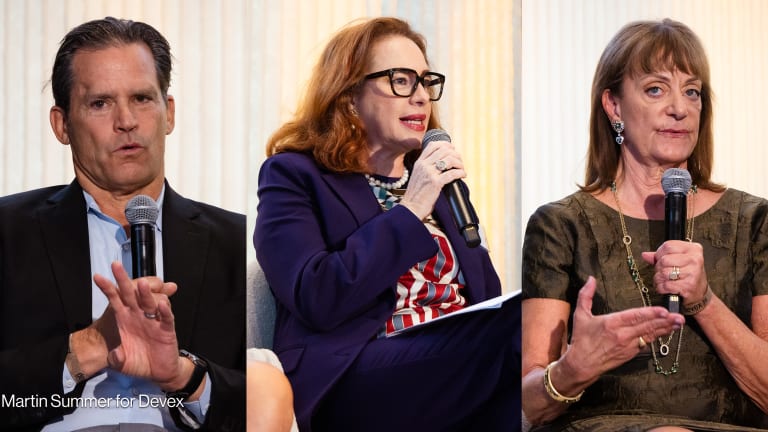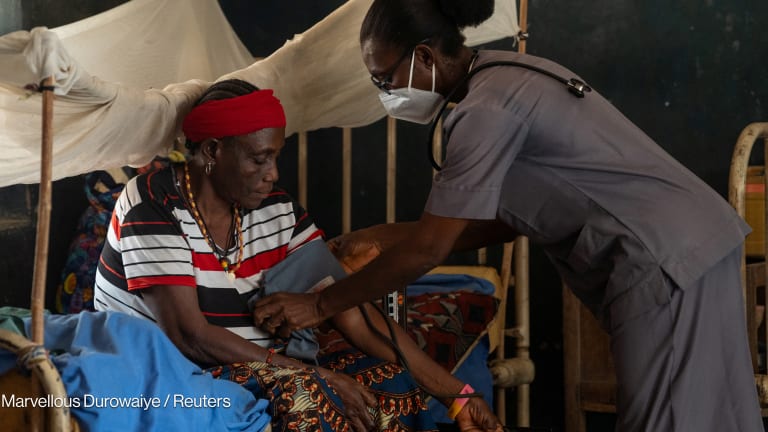
This article is produced and published by Devex Impact, a global initiative of Devex and USAID, that focuses on the intersection of business and global development and connects companies, organizations and professionals to the practical information they need to make an impact.
Recently described as ”one of the riskiest markets for foreign investment,” Burma is the frontier market of the moment. Multinationals, including Master Card, Coca-Cola and HTC, are already on the ground, and many more are looking to enter.
While Burma, with a population of nearly 50 million and abundant natural resources, offers a wide range of business opportunities, it is also rife with development challenges. The country is the poorest in Southeast Asia, is vulnerable to cyclones and other natural disasters, and is plagued by corruption.
Greg Beck, deputy assistant administrator for USAID’s Asia Bureau and a frequent visitor to Burma, talked with Devex Impact about challenges on the ground for private companies entering Burma and how partnership can mitigate the risks of market entry.
What do companies interested in Burma need to know about the transition taking place there?
The past year has been a time of tremendous change for Burma. It’s incredible how quickly the transition has taken place. For the most part, it has been well-managed. A transition like this can create great uncertainty and risk, and it can take all shapes and forms, as we’ve seen in Syria, Libya and Tunisia. But in Burma right now, the risks are manageable risks. For American companies interested in engaging with Burma, now is the time.
Burma’s transition has been influenced by a number of factors, but managed primarily from the top. It has worked reasonably well largely because President Thein Sein has come together with many stakeholders to develop what I think is a very clear vision for the country. He is determined to avoid having an economy dependent on natural resources and to have a political system that will be open and responsive to the people.
Those are lofty goals considering where Burma is coming from, but in our discussions with President Thein Sein, the parliament, and leaders from the private sector and civil society, there is a great sense of hope. Still a number of concerns but nonetheless hopeful.
Which multinational companies are already on the ground in Burma?
There’s already been tremendous private sector engagement from the Chinese, Malaysians, Thai, Indians, Taiwanese, and Koreans. More private sector engagement from American companies will help to raise the bar. The American private sector goes in with a business model of transparency and accountability. Those are the types of values that interest the people of Burma, and the American private sector can be a role model.
What are USAID’s priorities for Burma?
The US-Burma Partnership for Democracy Peace and Prosperity with Burma, which President Obama outlined in his visit to the country in November, 2012, has four pillars: democracy, human rights and the rule of law; transparent governance; peace and reconciliation; and prosperity. We see a lot of opportunities for the private sector in many of these areas.
The entire aid-scape in Asia is changing rapidly, and if we don’t change our model, we risk becoming irrelevant. USAID administrator, Dr. Raj Shah, has challenged us to create a “model mission” in Burma, and one component of that is engaging with the private sector from the very beginning.
How will USAID contribute to the economic development of Burma?
If you look at the human and economic resources available, it’s going to be the private sector that sustains growth. We will engage around key priority areas and make a difference through building partnerships and leveraging resources.
As President Thein said to Secretary Clinton in Cambodia last spring, Burma does not want to be a long-term aid recipient. They need a hand-up. The country has always had strong academic institutions, tremendous resources, both human and natural, and it belongs to a dynamic part of the world, with Thailand, India, China and Indonesia as neighbors.
In all the years I’ve worked with Burma, one thing has struck me as remarkable: It was a very closed and repressive society in the past, but there has always been a thriving civil society. That speaks to the tenacity, creativity and ingenuity of the Burmese people. Those are the human resources we need to tap into. It’s important to bring in innovative models from outside, but we need to ground-truth those models with the Burmese people and build on strengths that already exist. It isn’t a blank sheet of paper. Our job is to identify those areas of capacity and build on them.
The strength of Burmese civil society also speaks to the work of our non-governmental organization and community-based organization colleagues. As we lean into our work with civil society, we’ll be putting those national institutions and organizations front and center in all the work we do. That strategy fits nicely with USAID Forward, which calls for capturing and promoting local opportunities and developing resources already on the ground.
Has the Burmese government been successful at making changes to facilitate private sector investment?
The political reforms are moving along better than was expected a year ago. It’s the area of economic reforms where more progress will be helpful to develop a climate for foreign investment. We’ll be providing support to parliamentarians so they can pass laws [to enable investment.] Burma is now part of ASEAN, and they will be able to look at what’s worked in places such as Indonesia and Thailand. We also want to engage private sector companies who have worked in the region to help develop these economic reforms.
The struggle for the government is that their bandwidth hasn’t really changed significantly since transition. The president has a clear view for the country, and there are some strong reformists in the government, but beyond that the bench strength is not yet deep.
When President Obama and Secretary Clinton spoke with Assistant Administrator for Asia, Nisha Biswal, [Burma mission director] Chris Milligan, and me, the president emphasized the importance of supporting the democratic reforms while also reiterating that if we don’t make this a “felt experience” for the Burmese people, the transition will struggle. That’s the fourth pillar of our partnership with Burma: A focus on prosperity. How do we link up these reforms so the people of Burma feel the difference? The question is how can we develop niche markets within agriculture, not only to sustain Burma’s people but to encourage trade and investment that supports a broad-based and inclusive economy?
We’ll be connecting our work in health, food security and agriculture to the important economic reforms. In December, we launched a new call for proposals, so American academic institutions, the American private sector and Burmese academic institutions can focus on key development challenges and find that nexus where we can work together for the betterment of the country.
What are the key challenges from multinational businesses looking to enter Burma?
There’s a significant lack of infrastructure. The roads are poor, the railway system is old, and outside of urban areas, you have Internet penetration of only 10 to 15 percent. There is layer upon layer of rules and regulations and, of course, the issue of corruption. The number of challenges is amazing, and we don’t have all the answers. This is why we are engaging the private sector from the beginning, to find out where that nexus lies between development priorities and private-sector interests. One clear area of shared interest is workforce development and transparent governance.
Where are the opportunities for businesses looking to invest in Burma?
Across the board there are tremendous opportunities, such as in technology and manufacturing. The U.S. Chamber of Commerce organized a mission to Burma in February , and a large number of high-tech companies were part of that delegation.
We are looking at how we can work with the private sector in the area of governance. Can we find new ways to connect the people to its government through the use of mobile technology? As in other parts of the developing world, we could see incredibly quick penetration with cell phones, and mobile banking could be transformative in terms of fighting corruption: You get the rent-seekers out of the way when paying staff salaries or receiving money from the Burmese diaspora.
Which companies would benefit most from working with USAID?
Companies like Coca-Cola, which began operating in Burma again last year, have worked innumerable times in transition environments, and they’ve been quite successful. They are already working with Pact to support women entrepreneurs in Burma. Johnson & Johnson is already working with us and other partners to promote child survival and maternal health in Burma.
I think companies without prior experience in transition environments can really benefit from working with USAID. We have our ear to the ground, we are building up relationships with civil society, the government and local private sector, and we are ready to share that contextual knowledge. For small companies especially, partnership is a great option. I can’t tell you how many people I’ve met in Rangoon, who’ve arrived with high expectations but left disappointed, simply because they’d never traversed those waters before. Partnering with USAID or international NGOs or local civil society organizations in Burma can help those companies navigate these waters more successfully to ultimately bring increased economic opportunities to the people of Burma.
For companies interested in working with USAID, I would say: Engage with us both at our Washington D.C. office and out at the mission in Burma. We want to hear creative, innovative solutions from the private sector for these development challenges we’ve identified as priorities.
Join the 500,000-strong Devex community to network with peers, discover talent and forge new partnerships – it’s free! Then sign up for the Devex Impact newsletter to receive cutting-edge news and analysis every month on the intersection of business and development.
Explore related content:








